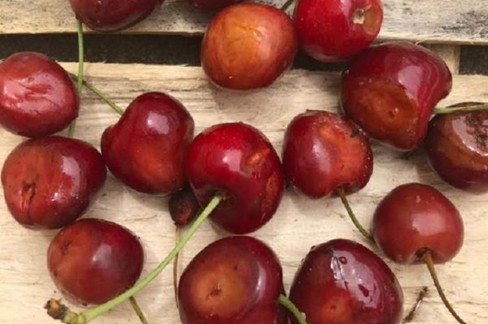Symptoms of little cherry disease — which include small size, poor color, and bitter-tasting cherries — are only visible on the fruit. This can make diagnosis complicated because the signs of ripeness only appear a couple of weeks before harvest.
Healthy cherries (left) are compared with cherries of the same variety infected with little cherry disease. Photo courtesy of Washington State University
Little cherry disease returns
Little cherry disease (LCD), first recognized in the 1930s, is prevalent again in Washington state orchards. Although the last major epidemic ended in the 1950s, the disease has returned with the passage of time and changes in orchard management practices, according to Washington State University.
Since 2010 LCD has become a statewide problem, resulting in unpicked limbs/trees, tree removal, and even orchard removal, WSU says.
Growers raise concern
How worried are Pacific Northwest cherry growers? Could LCD — also known as X-disease or Western X — become their version of Huanglongbing (HLB), the bacterial disease that has devastated the citrus industry in Florida?
American Fruit Grower posed that scenario in its 2025 State of the Fruit and Nut Industry survey.
For starters, several cherry growers — all quotes in this story are attributed to Washington-based operations unless otherwise noted — indicate that LCD has already damaged their orchards.
“We have lost thousands of trees and have pulled over 100 acres (circa 40 ettari) of cherries because of Western X. It is real, and it is scary.”
“We have experienced and pulled blocks.”
“I have been greatly affected and have dealt with it with aggressive tree removal.”
“Our acreage of cherries is down from 400 to 126 (circa da 162 a 51 ettari) due to Little Cherry Disease.”
“Yes, (we’re) taking trees out all the time and pushing some whole blocks.”
Mixed reactions from growers
Many respondents say they have not been affected. But even some of those growers are not turning their backs on the spread of LCD.
“We have not been affected,” a Utah grower says, “but we are very fearful of this disease.”
“So far surviving.”
“You have to live with it, but it’s one more challenge for new planting.”
Managing the threat
Could LCD turn into a PNW version of HLB?
“I don’t think it will be as bad as HLB. With new fast detection systems being developed, I’m hopeful. We stay on top of tree removal and leaf hopper sprays.”
Can operations do anything to minimize the presence of LCD?
“It depends on whether or not growers understand why LCD occurs and then take appropriate actions,” a Colorado grower says.
“Remove sick trees and old blocks. Plant new blocks and varieties at higher density.”
“Just keep replanting.”
Small farmers are already vigilant to the issue, according to one grower, who adds, “Large corporate farms are not tracking this and are spreading it.”
Some growers view the issue differently.
“My cherries are already small. We have 600 pie cherry trees of three cultivars,” a Colorado grower says.
“(LCD) is real and will hopefully be a factor to keep cherry production in check over time.”
Thomas Skernivitz
Growing Produce
Image source: Growing Produce / WSU
Cherry Times - All rights reserved










